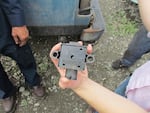
This anti-lock brake system (ABS) from a Chrysler Jeep Grand Cherokee contains three mercury switches used to sense changes in speed as vehicle braked. Washington Ecology has collected 200,000 auto mercury switches.
Washingtn Department of Ecology
Here’s an interesting milestone. Washington’s Department of Ecology recently collected its 200,000th automobile switch containing mercury. That represents 445 pounds of mercury that did not end up in the environment.
Four hundred forty-five pounds, you say? Doesn’t seem like very much mercury. That’s what I thought, so I called Kathy Davis at Ecology to make sure I got the number right.
“Four-hundred forty five is actually a lot. It’s a very small, light material,” Davis said. And it’s very, very toxic.
Mercury is one of a number of chemicals considered a Persistent Bioaccumulative Toxic, or PBT. "Those are the worst of the worst," Davis said. Basically, these chemicals hang around for a really long time and get into the food chain, harming animals and humans.
The mercury switch itself is small,
about the size of a new acorn.
Mercury is still used safely in a number of products, like some kinds of light bulbs and other household switches. Automobile switches using mercury are no longer made. Ecology's press release notes:
“Mercury switches were used until 2003 for convenience lights under hoods and in trunks, as well as in early anti-lock braking and airbag systems. In 2003, mercury switches were phased out. But many of these older cars are still on the road.”
The problem with auto switches is the way cars are disposed of at the end of their life.
“If mercury switches are not removed, mercury escapes into the air and contaminates soils and stormwater when these vehicles are crushed, stored and recycled. Mercury can evaporate into the air and be deposited into water and soil. Fish collect mercury in their bodies. This can then be a source of mercury exposure to people who consume the fish.”
That's where the recycling program comes in. Ecology's Automobile Mercury Switch Removal Program is part of an EPA effort -- National Vehicle Mercury Switch Recovery Program -- to remove these from the environment. The program began in 2006 and continues today, though initial incentive monies encouraging states to participate are gone. Some states continue the program where mandated by law. Others, like Washington, continue through state-funded programs.
The EPA's goal for the program is to collect 80 to 90 percents of all the mercury switches by 2017, when the the NVMSR program ends.
-- Toni Tabora-Roberts
